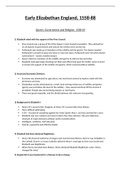Early Elizabethan England, 1558-88
Queen, Government and Religion, 1558-69
1) Elizabeth ruled with the support of the Privy Council.
Privy Council was a group of 20 of the Queen’s most trusted counsellors. They advised her
on all aspects of government and ensures her wishes were carried out.
Parliament was made up of members of the nobility and the gentry. The Queen needed
Parliament’s consent to pass new laws or raise new taxes. Parliament only met when Queen
summoned it – Queen avoided using it.
Queen relied on members of the nobility and gentry to enforce law and order.
Elizabeth used patronage (handing out titles and offices that gave the holder some income)
to ensure the support of the nobility and gentry, which ensured political stability.
2) Social and Economic Divisions.
Economy was dominated by agriculture, but merchants started to explore trade with the
Americans and Asia.
Elizabethan society dominated by a small, land-owning aristocracy of nobility and gentry
(gentry was just below the level of the nobility – they owned and lived off the income it
provided). People also earned being lawyers or merchants.
There was great inequality, and the divide between rich and poor was growing.
3) Background to Elizabeth I.
Henry VII’s second child. Daughter of Henry VII’s second wife Anne Boleyn.
Had a difficult upbringing.
1554 – Accused of conspiring against her sister Queen Mary I, and was arrested for a year.
Elizabeth was very cautious and only trusted a few close advisers. She was indecisive –
reluctant to make decisions without careful considerations.
Intelligent, confident, well educated.
Overall, a powerful and effective leader.
4) Elizabeth had been declared Illegitimate.
Henry VIII divorced Catherine of Aragon and married Anne Boleyn. Divorce was forbidden in
the Catholic Church, so many Catholics believed Henry’s marriage to Anne was invalid and
Elizabeth was illegitimate.
When Henry executed Anne Boleyn, Henry declared Elizabeth illegitimate. Later, Henry
changed his mind.
5) People felt it was Unnatural for a Woman to be in charge.
, Most people believed monarch should be a man.
Violence and chaos of Mary I’s reign reinforced people’s belief that women couldn’t rule
successfully.
Most people expected Elizabeth to act as a figurehead without any real power. They thought
she should let her male counsellors take control, or find a husband to govern for her.
6) She was expected to Marry and produce an Heir.
Pressure for Elizabeth to find a husband to rule for her.
If Elizabeth died without an heir, there would be a risk of civil war, with different groups
competing for the throne. To prevent this, Elizabeth was expected to marry and produce an
heir ASAP.
Elizabeth was reluctant to marry – would lost power and freedom.
7) English Economy was Weak.
Under King Edward VI, huge sums of money spent on wars in Scotland. Queen Mary I also
spent too much. This meant Elizabeth inherited huge debts.
Taxation system was old-fashioned and ineffective. Ordinary people faced high taxes, whilst
members of the nobility and gentry paid less tax than they owed.
England suffering high levels of inflation. Means prices were rising, while wages stayed the
same or fell. The poor were hit hardest by inflation.
Elizabeth was reluctant to reform the tax system and raise taxes as she feared it would upset
the nobility and gentry who supported her government.
8) Elizabeth Ended the War with France.
1557 – Mary I took England to war vs France, to support her husband Philip II of Spain, who
was already fighting France.
1558 – French conquered Calais, England’s last remaining territory in Europe, making it
harder for England to control the Channel, and increased the risk of a French invasion.
When Elizabeth became Queen (1558), she wanted to end the war with France ASAP.
1559 – Peace agreed.
Throughout her reign, Elizabeth tried avoiding foreign wars, due to England’s financial
weakness. She feared raising taxes to pay for a war would be unpopular and fuel opposition
to her rule.
9) French Threat in Scotland.
, Scotland controlled by France’s Catholic royal family, and there were many French troops in
the country.
1558 – Mary Queen of Scots married heir to the French throne. Mary’s marriage increased
the risk the French may invade England from Scotland to try and put her on the English
throne, because Catholic France wanted England to be Catholic too.
There were many Catholics in England who wanted a Catholic monarch. If France invaded,
Catholics may betray Elizabeth and support the French.
Late 1550s – Scottish Protestants rebelled vs French rule. England troops and ships sent to
help them. French were defeated and forced to leave Scotland. This greatly reduced the
threat of invasion.
French Wars of Religion (1562-1598) was a civil war between Catholics and Protestants,
which weakened France and removed threat of a French invasion.
10) Protestant Reformation.
They believed Christians were saved by faith, not by good deeds.
Questioned authority of the Pope.
Translated Bible from Latin into languages people understood.
Thought churches should be plain and simple, but kept vestments.
11) Henry VIII Broke Away from Roman Catholic Church.
Until 1530s, England was a Catholic country, and most people were Catholics.
In early 1530s, Henry divorced his first wife. The Pope refused to accept the divorce, so
Henry broke away from the Roman Catholic Church, and made himself head of the Church of
England.
He didn’t try to reform the English Church, so Catholic beliefs and practices remained largely
unchanged.
12) Edward VI made England More Protestant.
Reformed English Church to Protestantism.
Made churches and church service simpler. Statues and decorations removed. Priests not
allowed to wear their Catholic vestments. New, Protestant Bible was issued, and church
service held in English, not Latin.
13) Mary I restored Catholicism.
She restored the Pope as head of the English Church and brought back Catholic beliefs and
practices.
Protestants were harshly persecuted.
14) Elizabeth I wanted Religious Stability.





